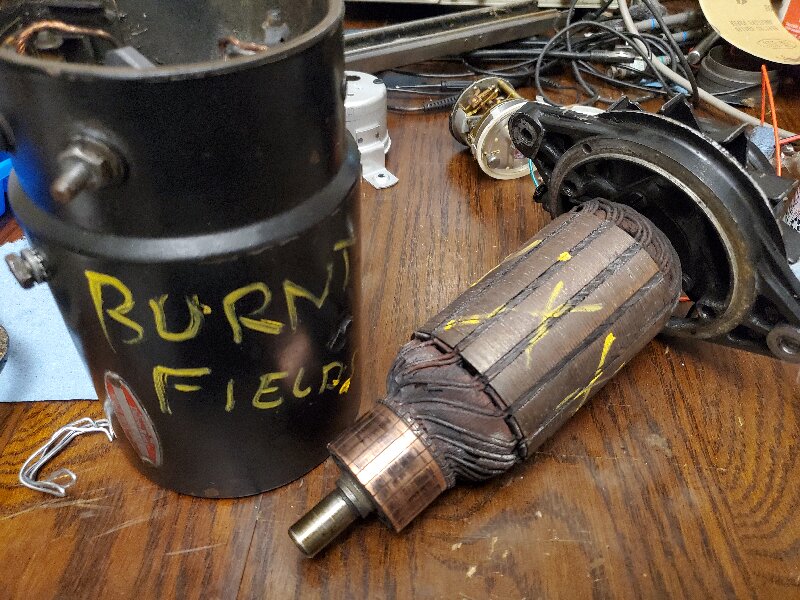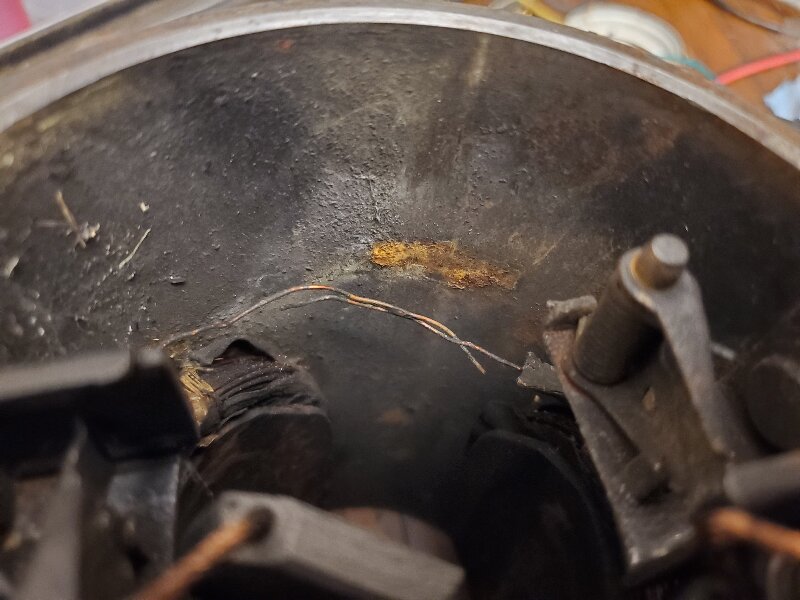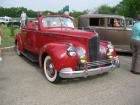|
Generator Testing
|
||||
|---|---|---|---|---|
|
Home away from home
|
Recently I was gifted a Delco Remy 1102008 generator off of a 56 car whose owner complained it was not working, and that replacing the generator fixed the charging system. The owner also took it to a generator shop which diagnosed it as having a bad armature AND field.
Upon first inspection the mechanical condition seemed good. The brushes seemed seated normally for new brushes, but I re-seated them anyway with 2 passes of 120 grit. This did not effect the wear marks much after a couple thousand spins with a cordless drill. Brush spring tension was normal at 25 oz. (spec. 28oz.). The armature read 2.3V @ 10A straight across and about 3.3V across the outside terminals when tested with a power supply. The field resistance was about 7½Ω. After grounding the field terminal to the case I performed a motoring test by powering the armature and ground with an external 14V supply. Sometimes the generator would not spin up fully and would reach the maximum draw of my PSU (10A) @ about 4V. Other times it would spin up past this and reach a steady state load of 6½A @ 14V. The same would occur if the arm velocity was assisted by a drill spinning the pulley nut. I then tested the self excitation and found the unit to reach 10V @ 1500RPM steady state, and would quickly reach 18V+ @ 2000 RPM. I noticed there was a firm but sloppy repair to the field jumper wire. (There was some old loose tape on it originally and I covered the connection with electrical tape after taking the photo.) This wire is often damaged on a generator from carelessly inserting the bolt. I suspect the shop saw this and thought there was a problem with the field, though for me the ohm reading was correct from the start. I don't know why the armature was considered to be problematic, as it seems to be in satisfactory condition overall, though I don't have the equipment to test it completely. Now, I do know that if you connect a self-powered field to the arm terminal instead of ground that the generator will fail to self-excite. It's an easy mistake to make when testing, especially since generators are made both ways. (Though I think Delco made them all the same, which is also the industry standard; Ford being the major outlier.) So I wonder if the shop did something like this. Anyone have any ideas for why I and this generator shop (& previous owner) seemed to have such different experiences on this generator? Besides the brushes being broken in slightly better for me, I can't imagine there was much difference. My current suspicion is that the repaired field wire was shorting to the case, and disrupting the strength and form of the stator field.
Posted on: 2024/10/17 22:44
|
|||
|
1955 400 | Registry | Project Blog
1955 Clipper Deluxe | Registry | Project Blog 1955 Clipper Super Panama | Registry Email (Parts/service inquiries only, please. Post all questions on the forum.) service@ultramatic.info |
||||
|
||||
|
Re: Generator Testing
|
||||
|---|---|---|---|---|
|
Home away from home
|
Also Ross has a whole library of old generators if anyone needs one he probably has it.
Posted on: 2024/10/18 5:15
|
|||
|
1955 400 | Registry | Project Blog
1955 Clipper Deluxe | Registry | Project Blog 1955 Clipper Super Panama | Registry Email (Parts/service inquiries only, please. Post all questions on the forum.) service@ultramatic.info |
||||
|
||||

 20241017_214930.jpg (424.20 KB)
20241017_214930.jpg (424.20 KB)









